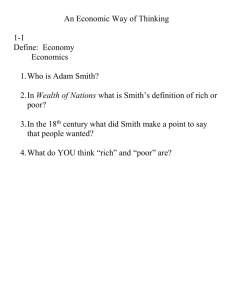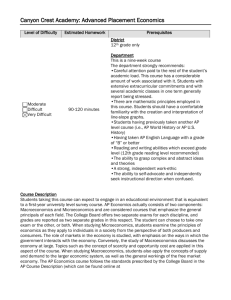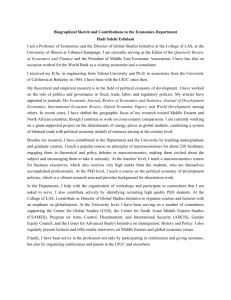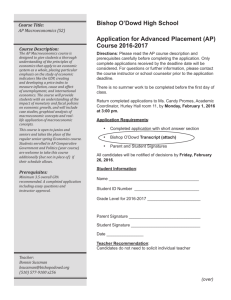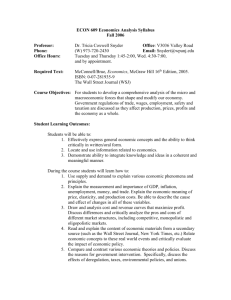Chapter 33: Open Economy Macroeconomics: The
advertisement
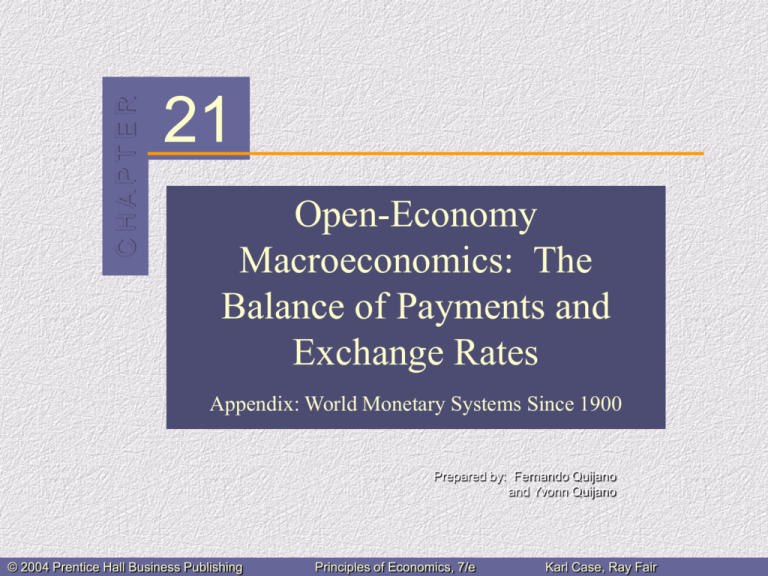
CHAPTER 21 Open-Economy Macroeconomics: The Balance of Payments and Exchange Rates Appendix: World Monetary Systems Since 1900 Prepared by: Fernando Quijano and Yvonn Quijano © 2004 Prentice Hall Business Publishing Principles of Economics, 7/e Karl Case, Ray Fair C H A P T E R 21: Open-Economy Macroeconomics: The Balance of Payments and Exchange Rates Exchange Rates • The main difference between an international transaction and a domestic transaction concerns currency exchange. • International exchange must be managed in a way that allows each partner in the transaction to wind up with his or her own currency. © 2004 Prentice Hall Business Publishing Principles of Economics, 7/e Karl Case, Ray Fair 2 of 53 C H A P T E R 21: Open-Economy Macroeconomics: The Balance of Payments and Exchange Rates Exchange Rates • The exchange rate is the price of one country’s currency in terms of another country’s currency; the ratio at which two currencies are traded for each other. © 2004 Prentice Hall Business Publishing Principles of Economics, 7/e Karl Case, Ray Fair 3 of 53 C H A P T E R 21: Open-Economy Macroeconomics: The Balance of Payments and Exchange Rates The Balance of Payments • Foreign exchange is simply all currencies other than the domestic currency of a given country. © 2004 Prentice Hall Business Publishing Principles of Economics, 7/e Karl Case, Ray Fair 4 of 53 C H A P T E R 21: Open-Economy Macroeconomics: The Balance of Payments and Exchange Rates The Balance of Payments • The balance of payments is the record of a country’s transactions in goods, services, and assets with the rest of the world; also the record of a country’s sources (supply) and uses (demand) of foreign exchange. © 2004 Prentice Hall Business Publishing Principles of Economics, 7/e Karl Case, Ray Fair 5 of 53 C H A P T E R 21: Open-Economy Macroeconomics: The Balance of Payments and Exchange Rates The Current Account United States Balance of Payments, 2002 CURRENT ACCOUNT Goods exports Goods imports (1) Net export of goods 682.6 – 1,166.9 – 484.3 Export of services Import of services (2) Net export of services 289.3 – 240.5 48.8 Income received on investments Income payments on investments 244.6 – 256.5 (3) Net investment income (4) Net transfer payments (5) Balance on current account (1 + 2 + 3 + 4) CAPITAL ACCOUNT (6) Change in private U.S. assets abroad (increase is –) (7) Change in foreign private assets in the United States (8) Change in U.S. government assets abroad (increase is –) (9) Change in foreign government assets in the United States (10) Balance on capital account (6 + 7 + 8 + 9) (11) Statistical discrepancy (12) Balance of payments (5 + 10 + 11) © 2004 Prentice Hall Business Publishing Principles of Economics, 7/e – 11.9 – 56.0 – 503.4 – 152.9 533.7 – 3.3 46.6 474.1 29.3 0 Karl Case, Ray Fair 6 of 53 C H A P T E R 21: Open-Economy Macroeconomics: The Balance of Payments and Exchange Rates The Current Account • A country’s current account is the sum of its: • net exports (exports minus imports), • net income received from investments abroad, and • net transfer payments from abroad. © 2004 Prentice Hall Business Publishing Principles of Economics, 7/e Karl Case, Ray Fair 7 of 53 C H A P T E R 21: Open-Economy Macroeconomics: The Balance of Payments and Exchange Rates The Current Account • Exports earn foreign exchange and are a credit (+) item on the current account. Imports use up foreign exchange and are a debit (–) item. © 2004 Prentice Hall Business Publishing Principles of Economics, 7/e Karl Case, Ray Fair 8 of 53 C H A P T E R 21: Open-Economy Macroeconomics: The Balance of Payments and Exchange Rates The Current Account • The balance of trade is the difference between a country’s exports of goods and services and its imports of goods and services. • A trade deficit occurs when a country’s exports are less than its imports. • Net exports of goods and services (EX – IM), is the difference between a country’s total exports and total imports. © 2004 Prentice Hall Business Publishing Principles of Economics, 7/e Karl Case, Ray Fair 9 of 53 C H A P T E R 21: Open-Economy Macroeconomics: The Balance of Payments and Exchange Rates The Current Account • Investment income consists of holdings of foreign assets that yield dividends, interest, rent, and profits paid to U.S. asset holders (a source of foreign exchange). © 2004 Prentice Hall Business Publishing Principles of Economics, 7/e Karl Case, Ray Fair 10 of 53 C H A P T E R 21: Open-Economy Macroeconomics: The Balance of Payments and Exchange Rates The Current Account • Net transfer payments are the difference between payments from the United States to foreigners and payments from foreigners to the United States. © 2004 Prentice Hall Business Publishing Principles of Economics, 7/e Karl Case, Ray Fair 11 of 53 C H A P T E R 21: Open-Economy Macroeconomics: The Balance of Payments and Exchange Rates The Current Account • The balance on current account consists of net exports of goods, plus net exports of services, plus net investment income, plus net transfer payments. It shows how much a nation has spent relative to how much it has earned. © 2004 Prentice Hall Business Publishing Principles of Economics, 7/e Karl Case, Ray Fair 12 of 53 C H A P T E R 21: Open-Economy Macroeconomics: The Balance of Payments and Exchange Rates The Capital Account • For each transaction recorded in the current account, there is an offsetting transaction recorded in the capital account. • The capital account records the changes in assets and liabilities. © 2004 Prentice Hall Business Publishing Principles of Economics, 7/e Karl Case, Ray Fair 13 of 53 C H A P T E R 21: Open-Economy Macroeconomics: The Balance of Payments and Exchange Rates The Capital Account • The balance on capital account in the United States is the sum of the following (measured in a given period): • the change in private U.S. assets abroad • the change in foreign private assets in the United States • the change in U.S. government assets abroad, and • the change in foreign government assets in the United States © 2004 Prentice Hall Business Publishing Principles of Economics, 7/e Karl Case, Ray Fair 14 of 53 C H A P T E R 21: Open-Economy Macroeconomics: The Balance of Payments and Exchange Rates The Capital Account • In the absence of errors, the balance on capital account would equal the negative of the balance on current account. • If the capital account is positive, the change in foreign assets in the country is greater than the change in the country’s assets abroad, which is a decrease in the net wealth of the country. © 2004 Prentice Hall Business Publishing Principles of Economics, 7/e Karl Case, Ray Fair 15 of 53 C H A P T E R 21: Open-Economy Macroeconomics: The Balance of Payments and Exchange Rates The United States as a Debtor Nation • A country’s net wealth is the sum of all its past current account balances. • Prior to the mid-1970s, the United States was a creditor nation. After the mid-1970s, the United Sates began to have a negative net wealth position vis-à-vis the rest of the world. © 2004 Prentice Hall Business Publishing Principles of Economics, 7/e Karl Case, Ray Fair 16 of 53 C H A P T E R 21: Open-Economy Macroeconomics: The Balance of Payments and Exchange Rates The United States as a Debtor Nation • A negative net wealth position vis-àvis the rest of the world reflects the fact that the United States spent much more on foreign goods and services than it earned through the sales of its goods and services. © 2004 Prentice Hall Business Publishing Principles of Economics, 7/e Karl Case, Ray Fair 17 of 53 C H A P T E R 21: Open-Economy Macroeconomics: The Balance of Payments and Exchange Rates Equilibrium Output (Income) in an Open Economy Planned aggregate expenditure (AE) in an open economy: AE C I G EX IM • In equilibrium: C a bY Y C I G EX IM I I0 Y a bY I G EX mY Y bY mY a I G EX Y (1 b m) a I G EX G G0 EX EX 0 IM mY m = marginal propensity to import (or MPM) © 2004 Prentice Hall Business Publishing 1 Y* (a I G EX ) 1 b m multiplier autonomous expenditures Principles of Economics, 7/e Karl Case, Ray Fair 18 of 53 C H A P T E R 21: Open-Economy Macroeconomics: The Balance of Payments and Exchange Rates Equilibrium Output (Income) in an Open Economy • Exports contribute to an increase in autonomous expenditures and cause the planned aggregate expenditure function to shift upward. © 2004 Prentice Hall Business Publishing • Imports affect the value of the multiplier. After imports are included, the aggregate expenditure function rotates and equilibrium income decreases. Principles of Economics, 7/e Karl Case, Ray Fair 19 of 53 C H A P T E R 21: Open-Economy Macroeconomics: The Balance of Payments and Exchange Rates Imports and Exports and the Trade Feedback Effect • The determinants of imports are the same as the factors that affect consumption and investment behavior. • Spending on imports also depends on the relative prices of domestically produced and foreign-produced goods. © 2004 Prentice Hall Business Publishing Principles of Economics, 7/e Karl Case, Ray Fair 20 of 53 C H A P T E R 21: Open-Economy Macroeconomics: The Balance of Payments and Exchange Rates Imports and Exports and the Trade Feedback Effect • The demand for U.S. exports depends on economic activity in the rest of the world. If foreign output increases, U.S. exports tend to increase. • Because U.S. imports are somebody else’s exports, the extra import demand from the United States raises the exports of the rest of the world. © 2004 Prentice Hall Business Publishing Principles of Economics, 7/e Karl Case, Ray Fair 21 of 53 C H A P T E R 21: Open-Economy Macroeconomics: The Balance of Payments and Exchange Rates Imports and Exports and the Trade Feedback Effect • The trade feedback effect is the tendency for an increase in the economic activity of one country to lead to a worldwide increase in economic activity, which then feeds back to that country. © 2004 Prentice Hall Business Publishing Principles of Economics, 7/e Karl Case, Ray Fair 22 of 53 C H A P T E R 21: Open-Economy Macroeconomics: The Balance of Payments and Exchange Rates Imports and Export Prices and the Trade Feedback Effect • When the export prices of one country rise, with no change in the exchange rate, the import prices of another rise. • If the inflation rate abroad is high, U.S. import prices are likely to rise. © 2004 Prentice Hall Business Publishing Principles of Economics, 7/e Karl Case, Ray Fair 23 of 53 C H A P T E R 21: Open-Economy Macroeconomics: The Balance of Payments and Exchange Rates Imports and Export Prices and the Trade Feedback Effect • The price feedback effect is the process by which a domestic price increase in one country can “feed back” on itself through export and import prices. • Inflation is “exportable.” © 2004 Prentice Hall Business Publishing Principles of Economics, 7/e Karl Case, Ray Fair 24 of 53 C H A P T E R 21: Open-Economy Macroeconomics: The Balance of Payments and Exchange Rates The Open Economy with Flexible Exchange Rates • Floating, or market-determined, exchange rates are exchange rates determined by the unregulated forces of supply and demand. • Exchange rate movements have important impacts on imports, exports, and movement of capital between countries. © 2004 Prentice Hall Business Publishing Principles of Economics, 7/e Karl Case, Ray Fair 25 of 53 C H A P T E R 21: Open-Economy Macroeconomics: The Balance of Payments and Exchange Rates The Market for Foreign Exchange • In a world where there are only two countries, the United States and Britain, the demand for pounds is comprised of holders of dollars wishing to acquire pounds. The supply of pounds is comprised of holders of pounds seeking to exchange them for dollars. © 2004 Prentice Hall Business Publishing Principles of Economics, 7/e Karl Case, Ray Fair 26 of 53 C H A P T E R 21: Open-Economy Macroeconomics: The Balance of Payments and Exchange Rates The Market for Foreign Exchange Some Private Buyers and Sellers in International Exchange Markets: United States and Great Britain THE DEMAND FOR POUNDS (SUPPLY OF DOLLARS) 1. Firms, households, or governments that import British goods into the United States or wish to buy British-made goods and services 2. U.S. citizens traveling in Great Britain 3. Holders of dollars who want to buy British stocks, bonds, or other financial instruments 4. U.S. companies that want to invest in Great Britain 5. Speculators who anticipate a decline in the value of the dollar relative to the pound © 2004 Prentice Hall Business Publishing Principles of Economics, 7/e Karl Case, Ray Fair 27 of 53 C H A P T E R 21: Open-Economy Macroeconomics: The Balance of Payments and Exchange Rates The Market for Foreign Exchange Some Private Buyers and Sellers in International Exchange Markets: United States and Great Britain THE SUPPLY OF POUNDS (DEMAND FOR DOLLARS) 1. Firms, households, or governments that import U.S. goods into Great Britain or wish to buy U.S.-made goods and services 2. British citizens traveling in the United States 3. Holders of pounds who want to buy stocks, bonds, or other financial instruments in the United States 4. British companies that want to invest in the United States 5. Speculators who anticipate a rise in the value of the dollar relative to the pound © 2004 Prentice Hall Business Publishing Principles of Economics, 7/e Karl Case, Ray Fair 28 of 53 C H A P T E R 21: Open-Economy Macroeconomics: The Balance of Payments and Exchange Rates The Market for Foreign Exchange • The demand for pounds in the foreign exchange market shows a negative relationship between the price of pounds (dollars per pound) ($/£) and the quantity of pounds demanded. • When the price of pounds falls, British-made goods and services appear less expensive to U.S. buyers. If British prices are constant, U.S. buyers will buy more British goods and services, and the quantity demanded of pounds will rise. © 2004 Prentice Hall Business Publishing Principles of Economics, 7/e Karl Case, Ray Fair 29 of 53 C H A P T E R 21: Open-Economy Macroeconomics: The Balance of Payments and Exchange Rates The Market for Foreign Exchange • The supply of pounds in the foreign exchange market shows a positive relationship between the price of pounds (dollars per pound) ($/£) and the quantity of pounds supplied. • When the price of pounds rises, the British can obtain more dollars for each pound. This means that U.S.-made goods and services appear less expensive to British buyers. Thus, the quantity of pounds supplied is likely to rise with the exchange rate. © 2004 Prentice Hall Business Publishing Principles of Economics, 7/e Karl Case, Ray Fair 30 of 53 C H A P T E R 21: Open-Economy Macroeconomics: The Balance of Payments and Exchange Rates The Equilibrium Exchange Rate © 2004 Prentice Hall Business Publishing • The equilibrium exchange rate occurs at the point at which the quantity demanded of a foreign currency equals the quantity of that currency supplied. Principles of Economics, 7/e Karl Case, Ray Fair 31 of 53 C H A P T E R 21: Open-Economy Macroeconomics: The Balance of Payments and Exchange Rates The Equilibrium Exchange Rate • An excess supply of pounds will cause the price of pounds to fall— the pound will depreciate (fall in value) with respect to the dollar. • An excess demand for pounds will cause the price of pounds to rise— the pound will appreciate (rise in value) with respect to the dollar. © 2004 Prentice Hall Business Publishing Principles of Economics, 7/e Karl Case, Ray Fair 32 of 53 C H A P T E R 21: Open-Economy Macroeconomics: The Balance of Payments and Exchange Rates Factors that Affect Exchange Rates • Purchasing Power Parity: The Law of One Price If the costs of transportation are small, the price of the same good in different countries should be roughly the same. • If the law of one price held for all goods, and if each country consumed the same market basket of goods, the exchange rate between the two currencies would be determined simply by the relative price levels in the two countries. © 2004 Prentice Hall Business Publishing Principles of Economics, 7/e Karl Case, Ray Fair 33 of 53 C H A P T E R 21: Open-Economy Macroeconomics: The Balance of Payments and Exchange Rates Factors that Affect Exchange Rates • The theory that exchange rates are set so that the price of similar goods in different countries is the same is known as the purchasing-power parity. • If it takes ten times as many pesos to buy a pound of salt in Mexico as it takes U.S. dollars to buy a pound of salt in the United States, then the equilibrium exchange rate should be 10 pesos per dollar. © 2004 Prentice Hall Business Publishing Principles of Economics, 7/e Karl Case, Ray Fair 34 of 53 C H A P T E R 21: Open-Economy Macroeconomics: The Balance of Payments and Exchange Rates Factors that Affect Exchange Rates • A high rate of inflation in one country relative to another puts pressure on the exchange rate between the two countries, and there is a general tendency for the currencies of relative high-inflation countries to depreciate. © 2004 Prentice Hall Business Publishing Principles of Economics, 7/e Karl Case, Ray Fair 35 of 53 C H A P T E R 21: Open-Economy Macroeconomics: The Balance of Payments and Exchange Rates Factors that Affect Exchange Rates © 2004 Prentice Hall Business Publishing • A higher price level in the United States increases the demand for pounds and decreases the supply of pounds. The result is appreciation of the pound against the dollar. Principles of Economics, 7/e Karl Case, Ray Fair 36 of 53 C H A P T E R 21: Open-Economy Macroeconomics: The Balance of Payments and Exchange Rates Factors that Affect Exchange Rates • The level of a country’s interest rate relative to interest rates in other countries is another determinant of the exchange rate. If U.S. interest rates rise relative to British interest rates, British citizens may be attracted to U.S. securities. © 2004 Prentice Hall Business Publishing Principles of Economics, 7/e Karl Case, Ray Fair 37 of 53 C H A P T E R 21: Open-Economy Macroeconomics: The Balance of Payments and Exchange Rates Factors that Affect Exchange Rates © 2004 Prentice Hall Business Publishing • A higher interest rate in the United States increases the supply and decreases the demand for pounds. The result is depreciation of the pound against the dollar. Principles of Economics, 7/e Karl Case, Ray Fair 38 of 53 C H A P T E R 21: Open-Economy Macroeconomics: The Balance of Payments and Exchange Rates The Effects of Exchange Rates on the Economy • When a country’s currency depreciates (falls in value), its import prices rise and its export prices (in foreign currencies) fall. • When the U.S. dollar is cheap, U.S. products are more competitive in world markets, and foreign-made goods look expensive to U.S. citizens. © 2004 Prentice Hall Business Publishing Principles of Economics, 7/e Karl Case, Ray Fair 39 of 53 C H A P T E R 21: Open-Economy Macroeconomics: The Balance of Payments and Exchange Rates The Effects of Exchange Rates on the Economy • A depreciation of a country’s currency can serve as a stimulus to the economy: • Foreign buyers are likely to increase their spending on U.S. goods • Buyers substitute U.S.-made goods for imports • Aggregate expenditure on domestic output will rise • Inventories will fall • GDP (Y) will increase © 2004 Prentice Hall Business Publishing Principles of Economics, 7/e Karl Case, Ray Fair 40 of 53 C H A P T E R 21: Open-Economy Macroeconomics: The Balance of Payments and Exchange Rates Exchange Rates and the Balance of Trade: The J Curve • The balance of trade is equal to export revenue minus import costs: balance of trade = dollar price of exports x quantity of exports dollar price of imports x quantity of imports • According to the J-curve effect, the balance of trade gets worse before it gets better following a currency depreciation. © 2004 Prentice Hall Business Publishing Principles of Economics, 7/e Karl Case, Ray Fair 41 of 53 C H A P T E R 21: Open-Economy Macroeconomics: The Balance of Payments and Exchange Rates Exchange Rates and the Balance of Trade: The J Curve © 2004 Prentice Hall Business Publishing • Initially, the negative effect on the price of imports may dominate the positive effects of an increase in exports and a decrease in imports. • But when imports and exports have had a time to respond to price changes, the balance of trade improves. Principles of Economics, 7/e Karl Case, Ray Fair 42 of 53 C H A P T E R 21: Open-Economy Macroeconomics: The Balance of Payments and Exchange Rates Exchange Rates and Prices • Depreciation of a country’s currency tends to increase the price level. • Export demand rises. • Domestic buyers substitute domestic products for the now more expensive imports. • If the economy is operating close to capacity, the increase in aggregate demand is likely to result in higher prices. • If import prices rise, costs may rise for business firms, shifting the AS curve to the left. © 2004 Prentice Hall Business Publishing Principles of Economics, 7/e Karl Case, Ray Fair 43 of 53 C H A P T E R 21: Open-Economy Macroeconomics: The Balance of Payments and Exchange Rates Monetary Policy with Flexible Exchange Rates • Fed actions to lower interest rates result in a decrease in the demand for dollars and an increase in the supply of dollars, causing the dollar to depreciate. • If the purpose of the Fed is to stimulate the economy, dollar depreciation is a good thing. It increases U.S. exports and decreases imports. © 2004 Prentice Hall Business Publishing Principles of Economics, 7/e Karl Case, Ray Fair 44 of 53 C H A P T E R 21: Open-Economy Macroeconomics: The Balance of Payments and Exchange Rates Fiscal Policy with Flexible Exchange Rates • Flexible interest rates may not help in the attempt by government to cut taxes in order to stimulate the economy. • A tax cut results in increased household spending, but some of that spending leaks out as imports, reducing the multiplier. © 2004 Prentice Hall Business Publishing Principles of Economics, 7/e Karl Case, Ray Fair 45 of 53 C H A P T E R 21: Open-Economy Macroeconomics: The Balance of Payments and Exchange Rates Fiscal Policy with Flexible Exchange Rates • As income increases, the demand for money increases. The resulting higher interest rates cause the dollar to appreciate. Exports fall, imports rise, again reducing the multiplier. • If interest rates rise, private investment may be crowed out, also lowering the multiplier. © 2004 Prentice Hall Business Publishing Principles of Economics, 7/e Karl Case, Ray Fair 46 of 53 C H A P T E R 21: Open-Economy Macroeconomics: The Balance of Payments and Exchange Rates Monetary Policy with Fixed Exchange Rates • Monetary policy has no role in a country that has a fixed exchange rate. • For example, an attempt to lower interest rates results in currency depreciation and a lower (not a fixed) exchange rate. • In the absence of capital controls, the monetary authority loses its independence. © 2004 Prentice Hall Business Publishing Principles of Economics, 7/e Karl Case, Ray Fair 47 of 53 C H A P T E R 21: Open-Economy Macroeconomics: The Balance of Payments and Exchange Rates Appendix: World Monetary Systems Since 1900 THE GOLD STANDARD • Early in the century, during the gold standard era, nearly all currencies were backed by gold. Their values were fixed in terms of a specific number of ounces of gold, which determined their values in international trading— exchange rates. © 2004 Prentice Hall Business Publishing Principles of Economics, 7/e Karl Case, Ray Fair 48 of 53 C H A P T E R 21: Open-Economy Macroeconomics: The Balance of Payments and Exchange Rates Appendix: World Monetary Systems Since 1900 “PURE” FIXED EXCHANGE RATES • Under this type of system, governments set a particular fixed rate at which their currencies will exchange for each other. • There is no automatic mechanism to keep exchange rates aligned with each other, as with the gold standard. Therefore, governments must at times intervene to keep currencies aligned at their established values. © 2004 Prentice Hall Business Publishing Principles of Economics, 7/e Karl Case, Ray Fair 49 of 53 C H A P T E R 21: Open-Economy Macroeconomics: The Balance of Payments and Exchange Rates Appendix: World Monetary Systems Since 1900 © 2004 Prentice Hall Business Publishing Government Intervention in the Foreign Exchange Market • If the government has committed itself to keeping the value of the lira at .020, it must buy up the excess supply of lira (Qs – Qd). Principles of Economics, 7/e Karl Case, Ray Fair 50 of 53 C H A P T E R 21: Open-Economy Macroeconomics: The Balance of Payments and Exchange Rates Appendix: World Monetary Systems Since 1900 • At the end of World War II, economists from the United States and Europe met to formulate a new set of rules for exchange rate determination, known as the Bretton Woods system: 1. Countries were to maintain fixed exchange rates with each other. All currencies were fixed in terms of the U.S. dollar. 2. Countries experiencing a persistent current account deficit (or fundamental disequilibrium) in their balance of payments were allowed to change their exchange rates. © 2004 Prentice Hall Business Publishing Principles of Economics, 7/e Karl Case, Ray Fair 51 of 53 C H A P T E R 21: Open-Economy Macroeconomics: The Balance of Payments and Exchange Rates Appendix: World Monetary Systems Since 1900 • The alternative to a fixed exchange rate system is a flexible system: • In a freely floating system, governments do not intervene at all in the foreign exchange market. • In a managed floating system, governments intervene if markets are becoming disorderly. © 2004 Prentice Hall Business Publishing Principles of Economics, 7/e Karl Case, Ray Fair 52 of 53 C H A P T E R 21: Open-Economy Macroeconomics: The Balance of Payments and Exchange Rates Review Terms and Concepts appreciation of a currency foreign exchange balance of payments J-curve effect balance of trade law of one price balance on capital account marginal propensity to import (MPM) balance on current account depreciation of a currency net exports of goods and services (EX – IM) exchange rate price feedback effect floating, or market-determined, exchange rates purchasing-power-parity theory © 2004 Prentice Hall Business Publishing trade deficit trade feedback effect Principles of Economics, 7/e Karl Case, Ray Fair 53 of 53



